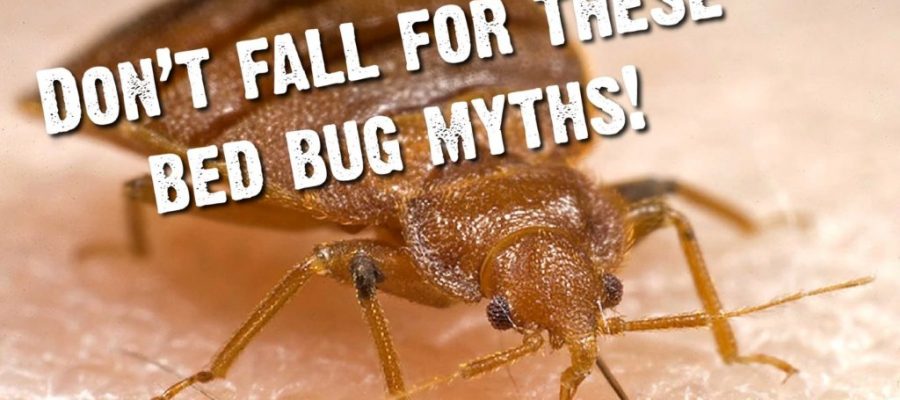7 Common Bed Bug Myths
- April 6, 2020
- in Pest Control
- by Ashley Dando
- 14
- 0

The 21st century has brought with it many significant innovations, but it has also brought back an old problem–bed bugs. Bed bugs have been resurfacing in the past few decades.
The reason for this seems to be pesticides. The continued use of pesticides has caused these pests to mutate and become immune.
Bed bugs can only live for a year at most, which means they reach maturity and reproduce quickly. Unfortunately, being able to reproduce rapidly means they can mutate quickly, too.
The resurgence of bed bugs is not necessarily a reason to panic, though. These pests aren’t as harmful as many people think. There are plenty of bed bug myths that have served to turn this tiny annoyance into a perceived crisis.
We’ll talk about the truth behind some of these myths in the paragraphs below. Keep reading to learn more!
It is false that bed bugs are too small to see. You can see bed bugs with the naked eye, especially if you have a lot of them.
That being said, they can be hard to recognize, especially if they’re alone or in a place that looks similar to them. For example, you may have trouble seeing a bed bug on a wood floor or mistake it for one of the watermarks that often occur on wood.
This is also false. It only takes 1-bed bug to start an infestation. And, while it is true that it’s easier for bed bugs to infest and hide in a dirty house, they can exist in many environments, so long as they can find spaces to hide.
There is a sort of cause and effect to a bed bug infestation. A house doesn’t have to be dirty to attract bed bugs, but a house with bed bugs will probably start to show some stains, develop a strange smell, and eventually become littered with discarded skins.
Deep cleaning your home can help to get rid of them, and may even stop them from coming back, however chances are
you’ll need professional assistance.
When a bed bug bites, depends just as much on you as it does on them. One of the big bed bug myths is that they only bite at night.
They have evolved to be nocturnal, coming out mostly when we’re asleep, but it’s not that simple. Technically, cats are also nocturnal. However, anybody who owns a cat knows that they sometimes come out during the day, be it to eat, use their litter box, or spend time with their human companions.
Bed bugs are similar. They’ll probably never want to play with you, but they have no problem coming into the light for a quick snack. They simply find it easier to eat when their prey is sleeping.
Beds are popular places for bed bugs to live, but they’re not the only place they can live. The only things bed bugs need are food, and small, dark, out-of-the-way places to live. They love to hide, and any place they can do that is good enough.
Not only can bed bugs make their homes in different places, but they will. If you have a bed bug infestation, you may find them in your beds, couches, floor, and other furniture.
This is a hard question to answer. Currently, there is no evidence that bed bugs can transfer diseases to their human hosts. Some studies claim bed bugs can carry diseases but are unable to transmit them.
Others suggest that bed bugs can transfer diseases, namely Chagas Disease, however, these sources have only studied the phenomenon in rodents.
With little corroboration, there’s no way to tell if the information is reliable.
There are a few health issues that may come from bed bugs, but these are often minor things, like mild pain or itching. However, some people are allergic to bed bugs, so you should be aware of this if you live with someone with severe allergies of any kind.
There’s also a danger of developing secondary infections, but this is from other sources coming into contact with open bites or cuts from scratching.
There are several myths associated with bed bug bites, so we’ll tackle a few of them at once. The first myth is that bed bugs bite in threes.
This is untrue. In reality, there’s often no pattern to the way bed bugs bite. They attack wherever and whenever they can. You may have a single bite in one area, but an entire line of bites in another.
Others say that being bitten in the night is clear indicator of a bed bug infestation. It’s not.
There are many different kinds of biting bugs, from fleas to mosquitoes. There’s no guarantee that your bite came from a bed bug. If you have several bites, that might be an indicator, but you still shouldn’t jump to conclusions.
There’s also a persistent myth that bed bugs bite everybody, so if you don’t have a bite, you don’t have bed bugs. This isn’t true.
In fact, nobody knows exactly what attracts bed bugs to certain people but, much like mosquitoes, bed bugs prefer to bite some people more than others. There are plenty of theories behind this, including blood type preference and ease of access.
Plus, depending on your body’s reaction, you can even be bitten and show no signs of or symptoms afterward.
There are all kinds of different bed bug myths out there. And, we’ve done our best to dispel a few of those today. If you still have some unanswered questions, take a look through our other blog posts on the subject.
And, if you want more information and advice on pest control, please visit our site or get in touch.
Have you seen a bed bug in your house? Check out these look-alikes that often fool people before taking action.